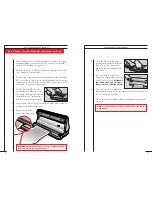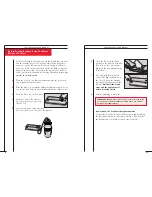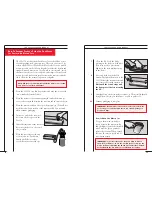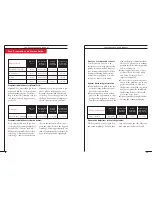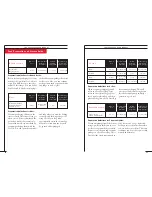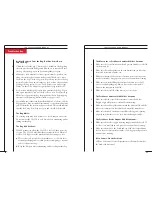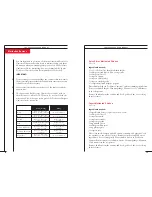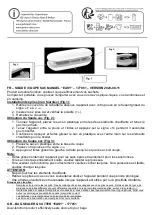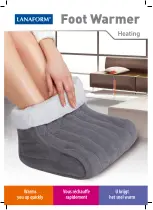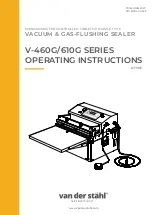
Food Preparation and Storage Guide
T H E F O O D S A V E R U S E R M A N U A L
21
Care and Cleaning Instructions
T H E F O O D S A V E R U S E R M A N U A L
20
The FoodSaver Vac 550
1
Always unplug the Vac 550 before cleaning.
2
Do not immerse the Vac 550 in water.
3
Do not use abrasive products or materials to clean any of the Vac 550
components. Such cleaners can scratch the surfaces and damage
the black foam rubber pads, preventing a vacuum from forming.
4
Clean using a mild dishwashing soap and a warm, damp cloth.
Wipe away any food residue from inside or around the vacuum
channel, sealing strip, and black foam rubber pads.
5
Dry thoroughly before using.
FoodSaver Bags
1
Wash bags in warm water using a mild dishwashing soap.
2
Bags can be washed in the dishwasher by carefully turning the
bags inside out and spreading them over the top rack of the dish-
washer, so that all surfaces are exposed to the washing water.
3
Allow bags to dry thoroughly before reusing.
FoodSaver Accessories
1
All FoodSaver accessories should be washed in warm water using
a mild dishwashing soap.
2
Dry thoroughly before using.
3
All FoodSaver Canister bases (but not the lids) may be washed in
the dishwasher.
4
Square and Bulk Storage Canister bases (but not the lids) may be
used to reheat foods in the microwave.
5
Designer Canister bases and lids are not to be used in the
microwave.
IMPORTANT: We do not recommend reusing bags that have been
used to store raw meats or fish. Also, bags may not be reusable
if they have been used to store greasy or fatty foods.
NOTE: Vacuum packaging is NOT a substitute for refrigeration or freezing.
Any perishable foods that require refrigeration prior to vacuum packaging
still must be refrigerated or frozen after vacuum packaging.
Guidelines for Vacuum
Packaging Food
Vacuum packaging is not a substitute
for canning nor can it reverse deteri-
orating quality; it can only slow down
changes in quality. It is impossible to
predict how long a specific food will
have top-quality flavor, appearance,
and texture, because it depends on
the age and condition of the food
on the day it was vacuum packaged.
Foods that are extremely fresh will
last longer than foods that are al-
ready deteriorating.
Vacuum packaging extends the life of
foods by removing nearly all the air in
a sealed container, thereby reducing
oxidation which affects nutritional
value, flavor, and overall quality.
However, most foods contain enough
water to support micro-organisms
which can grow with or without air.
While micro-organisms are present
everywhere, only certain ones cause
problems, and only under certain
conditions:
◗
Mold:
Easy to identify because of
its characteristic fuzz. Molds are
virtually eliminated by vacuum
packaging because they cannot
grow in a low oxygen environment.
◗
Yeast:
Results in fermentation,
which can frequently be identified
by smell or taste. Yeast requires
water, sugar, and a moderate tem-
perature to grow, and can grow
with or without air. Refrigeration
slows the growth of yeast, and
freezing stops it completely.
◗
Bacteria:
Frequently results in
discoloration, soft or slimy texture,
and/or an unpleasant odor. Clostrid-
ium botulinum (the organism that
causes Botulism), can grow without
air under the right conditions,
cannot be detected by smell or
taste, and although extremely rare,
can be very dangerous.
Maintaining low temperatures is a
critical factor in preserving foods
safely. Growth of micro-organisms is
significantly reduced at temperatures
of 40°F (4°C) or below. Freezing at
0°F (-17°C) does not kill micro-
organisms, but it stops them from
growing. For long term storage, always
freeze “perishable” foods that have
been vacuum packaged.
Thawing and Heating Vacuum
Packaged Foods
Always thaw foods in either the
refrigerator or microwave – do not
leave perishable foods at room tem-
perature to thaw.
To microwave in a FoodSaver Bag,
cut a corner of the bag and place on
a microwave-safe dish. You can also
place the FoodSaver Bag in boiling
water to heat.





